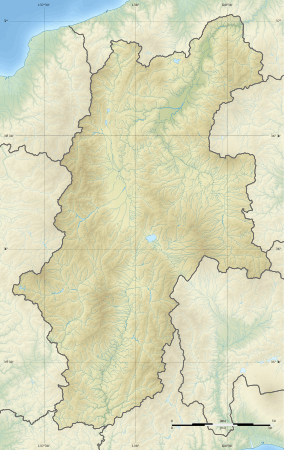Gonga Administrative Complex ruins
The Gonga Administrative Complex ruins (恒川官衙遺跡, Gonga kanga iseki) is an archaeological site containing the ruins of the Nara to early Heian period government administrative complex for Ina District , Shinano Province, located in what is now part of the town of Iida, Nagano in the Chūbu region of Japan. The site was designated a National Historic Site of Japan in 2014.[1]
恒川官衙遺跡 | |
 Gonga Administrative Complex Ruins  Gonga Administrative Complex ruins (Japan) | |
| Location | Iida, Nagano, Japan |
|---|---|
| Region | Chūbu region |
| Coordinates | 35°30′53″N 137°49′19″E |
| Type | settlement |
| History | |
| Periods | Nara to Heian period |
| Site notes | |
| Ownership | National Historic Site |
| Public access | None |
Overview
Following the Taika reforms of 645 AD and the establishment of the Ritsuryō system, Japan was administratively divided into provinces which were further subdivided into districts, each with an administrative center and tax warehouses designed per a common template.
The Gonga Administrative Complex site is located in the southern end of Ina Valley at the southern tip of modern Nagano Prefecture at an altitude of 320-430 meters. An excavation survey of the ruins began in 1974 by the Iida City Board of Education noted that the layout of the ruins was that of a typical district office during the Nara period, and further excavation surveys confirmed the extent of the ruins from 1986 to 1984.
The site dates from latter half of the 7th century and appears to have been in use through the early 10th century. It was a trapezoidal enclosure measuring 215 meters on its long side by 150 meters on its short side. The enclosure was not square, as was typical with similar complexes in other locations, as it was built next to an earlier keyhole-shaped kofun tumulus, which was not included within its borders. Inside the enclosure, the foundations of a warehouse complex for the storage of tax rice, an administrative building with an attached kitchen, and the remnants of a moat were discovered. The complex was destroyed in rebuilt several times through the Heian period. In the center of the complex was a pond fed by a natural spring, from which a large number of wooden artifacts were recovered. These included wooden tag markers, roof tiles, belt decorations, a large number of pottery shards, and numerous wadōkaichin coins, as well as objects which were clearly of some ritual significance.
References
- "Gonga kanga iseki" (in Japanese). Agency for Cultural Affairs.
External links
- Iida city official site (in Japanese)